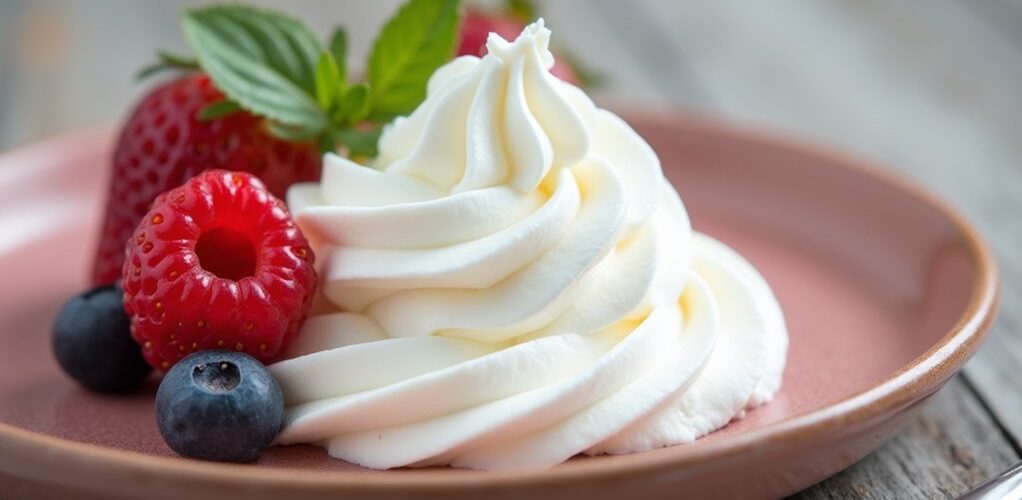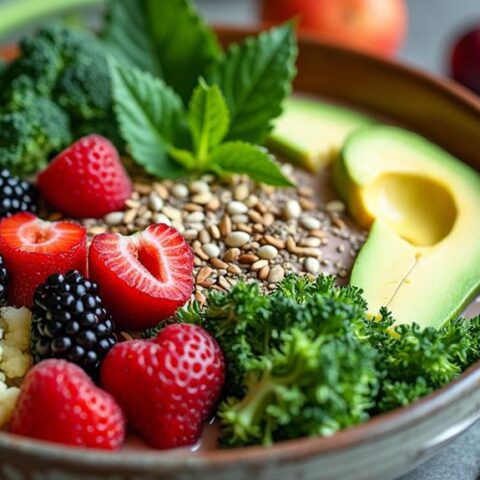
Whipped cream can be a suitable choice for low-carb diets, containing only 1 gram of carbohydrates per tablespoon in its pure, unsweetened form. Heavy whipping cream, with at least 36% milk fat, offers beneficial nutrients like vitamins A and E while promoting satiety. When selecting whipped cream, checking labels for added sugars is essential, as commercial varieties may contain hidden carbohydrates. Making homemade versions with keto-friendly sweeteners guarantees better control over carb content and reveals numerous serving possibilities.
Key Takeaways
- Pure whipped cream contains only 1 gram of carbohydrates per tablespoon, making it naturally low-carb and keto-friendly.
- Store-bought whipped creams may contain added sugars, so check labels carefully or make your own at home.
- Homemade whipped cream using heavy cream and sugar-free sweeteners has less than 1 gram of carbs per serving.
- Whipped cream contains healthy fats and fat-soluble vitamins while satisfying sweet cravings without spiking blood sugar.
- Traditional whipped cream contains just 0.4 grams of natural sugars per tablespoon, making it suitable for low-carb diets.
Understanding Whipped Cream Basics
When examining the fundamentals of whipped cream, it's essential to understand its core composition and nutritional profile.
As a high fat dairy product, whipped cream is primarily made from heavy whipping cream, which contains at least 36% milk fat, making it naturally suited for low-carb dietary preferences.
The nutritional composition of whipped cream aligns well with low-carb eating patterns, containing just 1 gram of carbohydrates per tablespoon serving.
While its rich, creamy texture might suggest otherwise, traditional whipped cream maintains a remarkably low carbohydrate content, with only 0.4 grams of natural sugars per tablespoon.
Despite its luxurious mouthfeel, pure whipped cream contains minimal carbohydrates, making it a guilt-free indulgence for low-carb lifestyle followers.
This minimal carbohydrate profile, combined with its high fat content, makes whipped cream a practical choice for those following carbohydrate-restricted eating plans.
Additionally, individual responses to the keto diet can vary significantly, making it important for those incorporating whipped cream into their diet to monitor their overall health and cholesterol levels regularly.
Carb Content in Different Types of Whipping Cream
Different types of whipping cream available in the market vary in their carbohydrate content, making it important for consumers to understand these distinctions.
For those following a low-carb diet, both heavy cream and whipping cream can be suitable options, especially when paired with sugar-free sweeteners.
- Heavy cream contains 1 gram of net carbs per tablespoon
- Whipping cream has 1.5 grams of net carbs per tablespoon
- A ¼ cup serving of heavy cream contains 1.75 grams of carbs
- Whipping cream in ¼ cup portions has slightly higher carb content
- Brand variations may include added sugars, affecting total carb count
When selecting whipped cream products, checking nutrition labels is crucial to guarantee they align with low-carb dietary goals. Hard Cheeses are another excellent low-carb option on a keto diet, providing protein and calcium with minimal carbs. Both varieties remain viable options for those monitoring their carbohydrate intake, provided they're used in moderation and without added sugars.
Choosing the Right Cream for Low-Carb Diets
Selecting the ideal cream for a low-carb lifestyle requires careful consideration of both nutritional content and intended use. For those following a keto diet, both heavy cream and whipping cream offer excellent low carb options, with heavy cream providing slightly more fat content per serving. When choosing between varieties, consider checking labels carefully for hidden sugars and opt for sugar-free alternatives when sweetening is needed. Keto-friendly sweeteners like Stevia and erythritol are recommended as they have minimal impact on blood sugar levels, making them suitable for maintaining ketosis.
| Cream Type | Net Carbs/Serving | Best Uses |
|---|---|---|
| Heavy Cream | 1g per serving | Cooking, baking |
| Whipping Cream | <1g per ¼ cup | Toppings, desserts |
| Light Cream | 1g per serving | Coffee, beverages |
To maintain low-carb goals, combine these creams with natural sweeteners like erythritol or monk fruit, ensuring delicious results without compromising dietary restrictions.
Making Keto-Friendly Whipped Cream at Home
Creating keto-friendly whipped cream at home offers a delicious and customizable alternative to store-bought versions. This low-carb whipped cream requires minimal ingredients and preparation, while delivering maximum satisfaction for those following a ketogenic lifestyle.
To make the ideal keto-friendly whipped cream, follow these essential steps:
- Start with cold heavy whipping cream and a chilled mixing bowl for best results.
- Add a powdered keto-friendly sweetener, such as erythritol, to taste.
- Include vanilla extract for enhanced flavor.
- Whip with an electric mixer for 3-5 minutes until stiff peaks form.
- Store in an airtight container for up to 3 days in the refrigerator.
A key consideration when making keto-friendly whipped cream is selecting the right cooking oils to ensure the finished product supports a low-carb, high-fat diet. With only 1 gram of net carbs per serving, this homemade whipped cream provides a perfect finishing touch for various low-carb desserts while maintaining ketosis.
Best Sugar Substitutes for Low-Carb Whipped Cream
The success of low-carb whipped cream hinges on choosing the right sugar substitute, as traditional sweeteners can quickly derail ketogenic and low-carb dietary goals. Several excellent options exist for creating sugar-free whipped cream that remains low in carbs while maintaining a delicious taste profile. Erythritol stands out as a popular choice due to its easy dissolution and minimal impact on blood sugar, while monk fruit sweetener offers zero-calorie sweetness in concentrated amounts. For ideal results, powdered versions of these sweeteners are recommended to achieve a smooth consistency. Allulose provides another viable option, closely mimicking sugar's properties without the carbohydrate content. Stevia, derived from natural plant sources, can also be effective when used carefully to avoid any bitter aftertaste that might affect the final product. Additionally, incorporating MCT Oil can enhance the ketogenic benefits of your whipped cream, providing a source of energy that supports ketosis while maintaining a deliciously creamy texture.
Heavy Cream Vs Whipping Cream: Which to Choose
Understanding the distinction between heavy cream and whipping cream can greatly impact the success of low-carb desserts and recipes. Both options are suitable for keto diets, containing minimal carbohydrates at 1.75 grams per quarter cup, but they serve different culinary purposes.
Key differences between these cream varieties include:
- Heavy cream contains a higher milk fat content of at least 36%
- Whipping cream features 30-36% milk fat content
- Heavy cream provides 5.4 grams of fat per tablespoon versus whipping cream's 4.6 grams
- Both varieties contain identical carbohydrate and sugar content (0.4 grams per tablespoon)
Heavy cream produces firmer peaks when whipped, while whipping cream offers a lighter texture.
For low-carb recipes requiring stability and structure, heavy cream is the best choice, while whipping cream works best for lighter toppings and garnishes. Monounsaturated fats found in whipping cream can improve heart health by lowering LDL cholesterol and raising HDL cholesterol.
Common Additives That Add Hidden Carbs
While pure whipped cream remains a low-carb option, commercial varieties often harbor hidden carbohydrates through various additives and sweeteners. Common additions include modified food starch, carrageenan, and corn syrup, which can greatly impact the suitability of whipped cream for those following a low-carb diet. Many flavored varieties pose particular challenges, with chocolate and fruit-infused options containing added sugars that can contribute 5 or more grams of carbs per serving. For those seeking to maintain ketosis or restrict carbohydrate intake, carefully examining ingredient lists becomes essential. Terms like "sugar," "corn syrup," and "high fructose corn syrup" signal potential hidden carbs. It's important to avoid sugary snacks and desserts like standard candy bars or ice cream, which typically contain high levels of carbs that can disrupt ketosis. Using pure heavy whipping cream and whipping it at home guarantees minimal carbohydrate content, typically less than 1 gram per serving.
Storing Your Low-Carb Whipped Cream
Proper storage practices play a key role in maintaining the quality and carb-free status of homemade whipped cream. To guarantee ideal texture and freshness, low-carb whipped cream should be stored in an airtight container in the refrigerator, where it can maintain its consistency for up to 2-3 days. For best results when storing whipped cream:
Store homemade low-carb whipped cream in an airtight container and refrigerate immediately to maintain its freshness and texture for several days.
- Keep portions small and make fresh batches frequently
- Store immediately in the refrigerator after preparation
- Use an airtight container to prevent absorption of other food odors
- Stir gently before use if separation occurs
- Pre-chill mixing bowls in the freezer for better consistency
It's important to remember that maintaining proper hydration and electrolytes is crucial for overall health while following a low-carb diet. While freezing low-carb whipped cream isn't recommended, proper refrigeration helps preserve its shape and texture. For the best experience, consider making only what can be consumed within 24 hours.
Perfect Pairings for Sugar-Free Whipped Cream
Sugar-free whipped cream enhances countless low-carb dishes with its luxurious texture and versatile nature. When paired with fresh berries, it amplifies their natural sweetness while maintaining minimal carbohydrate content, making it an ideal companion for keto-friendly treats. For those seeking indulgent low-carb desserts, whipped cream toppings can transform simple dishes into elegant offerings. Adding it to chocolate mousse or no-bake pumpkin pie creates a decadent finishing touch, while incorporating it into breakfast favorites like low-carb pancakes and waffles brings satisfaction to morning meals. Creative applications include mixing the whipped cream with cocoa powder or powdered peanut butter for a delightful dip. For invigorating options, consider pairing it with sugar-free gelatin or using it to complement keto-friendly cheesecakes for a satisfying dessert experience. Erythritol is a sugar substitute used in many keto desserts to maintain sweetness without increasing carbs.
Troubleshooting Your Low-Carb Whipped Cream
Creating low-carb whipped cream can present several challenges, from achieving the right texture to maintaining stability during storage.
Understanding common issues like grainy consistency, over-whipping, and separation can help home cooks troubleshoot their sugar-free whipped cream effectively.
Temperature control, proper ingredient selection, and careful monitoring during the whipping process are essential elements for consistently successful results that rival traditional whipped cream.
Common Whipping Problems Fixed
Many home cooks encounter challenges when whipping cream, but understanding common problems and their solutions can lead to perfect results every time.
When making low-carb whipped cream, proper technique and preparation are essential for achieving the perfect texture without compromising taste or consistency.
Here are key solutions to common whipping problems:
- Keep heavy cream and mixing bowl thoroughly chilled before starting
- Use powdered sweeteners instead of granulated ones to prevent graininess
- Stop whipping once medium to stiff peaks form to avoid butter formation
- Gently stir separated whipped cream to reincorporate liquid
- Add stabilizers like gelatin or cream cheese for longer-lasting structure
These simple adjustments can transform texture issues into consistently successful results, making low-carb whipped cream an ideal topping for various desserts.
Tips For Perfect Peaks
When endeavoring for perfect peaks in low-carb whipped cream, mastering the fundamental techniques can make all the difference between lackluster results and professional-quality toppings.
The process begins with thorough chilling of both the heavy whipping cream and mixing bowl, which promotes better volume and faster whipping times.
Starting at a low speed and gradually increasing to high allows proper air incorporation, essential for achieving the desired consistency. For ideal results, use powdered low-carb sweeteners instead of granulated varieties to prevent graininess in the final product.
Whip the cream until reaching either soft peaks for a lighter texture or stiff peaks for a more stable topping, being careful not to overwhip.
While stored whipped cream may separate, gentle stirring can restore its texture, though fresh preparation yields the best results.
Storage Solutions That Work
Although storing low-carb whipped cream presents unique challenges, proper storage techniques can help maintain its texture and freshness for several days. The key to successful storage solutions lies in proper temperature control and container selection.
- Store whipped cream in an airtight container in the refrigerator for 2-3 days maximum.
- Chill both the mixing bowl and cream thoroughly before whipping.
- Gently stir separated whipped cream to restore consistency.
- Avoid freezing to maintain ideal texture.
- Use powdered sweeteners to prevent grainy texture development during storage.
For best results, keep the whipped cream in the back of the refrigerator where temperatures remain most stable.
While stored whipped cream may lose some volume over time, following these guidelines will help preserve its quality and guarantee it remains suitable for your low-carb desserts.
Flavor Variations Without Adding Carbs
Despite its simple nature, whipped cream can be transformed into various flavorful creations without compromising its low-carb status. Home cooks can explore flavor variations through several carbohydrate-conscious additions, including almond and maple extracts, which enhance taste without increasing carbohydrate content.
For chocolate lovers, incorporating cocoa powder or raw cacao offers rich flavor while maintaining the whipped cream's low-carb profile.
Those seeking fruity notes can utilize berry powders or powdered freeze-dried berries in small quantities, while preserved lemon paste provides a citrus twist without adding unwanted carbs.
When selecting flavor enhancers, it's crucial to verify that all additions are sugar-free and contain minimal carbohydrates to guarantee the whipped cream remains suitable for ketogenic and low-carb dietary needs. Additionally, unsweetened almond milk is a keto-friendly milk alternative with only 1-2 grams of carbs per cup, making it a great option for those following a low-carb diet.
Health Benefits of Low-Carb Whipped Cream
Low-carb whipped cream offers substantial health benefits while serving as a delicious addition to ketogenic and low-carb lifestyles.
This versatile topping provides crucial nutrients and healthy fats while maintaining minimal carbohydrate content, making it an excellent choice for health-conscious individuals.
- Contains crucial fat-soluble vitamins A and E for immune system support
- Provides 4 grams of healthy fats per tablespoon to boost energy levels
- Promotes satiety, helping reduce overall caloric intake
- Only 1 gram of net carbs per serving, supporting ketosis
- Offers satisfaction for sweet cravings without blood sugar spikes
When prepared with sugar-free sweeteners like erythritol or monk fruit, low-carb whipped cream becomes an ideal complement to various desserts and beverages while supporting nutritional goals.
Its combination of crucial nutrients and minimal carbohydrates makes it a smart choice for those prioritizing their health.
Reading Labels: What to Watch For
Understanding whipped cream labels requires careful attention to detail, as manufacturers often include hidden carbohydrates and sugars that can derail a low-carb eating plan.
When examining nutrition labels, consumers should focus on the total net carbs per serving, seeking options with less than 1 gram to maintain ketogenic or low-carb dietary goals.
Careful inspection of ingredients lists reveals important information about added sugars and artificial additives that may compromise low-carb objectives.
Heavy whipping cream typically offers the best option for low-carb diets due to its higher fat content and minimal carbohydrates.
Shoppers should compare various brands' nutrition facts, as formulations can differ considerably. The ideal product contains pure cream with minimal additives, possibly including sugar-free sweeteners, while avoiding unnecessary fillers that could increase the carbohydrate content.
Tips for Perfect Peaks Every Time
The secret to achieving perfect peaks in whipped cream begins with thoroughly chilled equipment, as cold temperatures enable ideal air incorporation and structural stability.
Starting at a lower mixing speed helps prevent mess while allowing the cream to gradually build volume and strength.
The controlled approach to speed adjustment, moving from low to high, guarantees the cream develops the desired texture without risk of over-whipping or butter formation.
Cold Equipment Matters Most
Successfully creating perfectly whipped cream starts with one essential step: chilling your equipment. When cold equipment meets heavy whipping cream at the ideal temperature of 50°F, the results are consistently superior.
The process of achieving soft peaks becomes more efficient, and the final whipped cream is perfect in both texture and stability.
- Place mixing bowl in refrigerator for 10-15 minutes before starting
- Chill metal beaters alongside the bowl
- Keep heavy cream refrigerated until ready to use
- Maintain consistent cold temperature throughout the process
- Use equipment straight from refrigerator without delays
This temperature control strategy is important because it helps incorporate air more effectively into the cream, resulting in a lighter, fluffier texture that holds its shape.
Cold equipment also prevents the cream from warming during the whipping process, ensuring ideal results.
Watch Your Mixing Speed
Proper mixing speed control enhances whipped cream from good to exceptional, building upon the foundation of perfectly chilled equipment. When whipped cream is made, starting at low speed allows for gradual air incorporation before shifting to high speed for best texture.
| Stage | Speed | Time | Result |
|---|---|---|---|
| Initial | Low | 30s | Air incorporation |
| Building | Medium | 30s | Soft peaks |
| Final | High | 60s | Stiff peaks |
| Warning | Stop | – | Avoid butter |
The entire process typically takes 1.5 to 2 minutes at high speed, but constant monitoring is essential. Attentive observation helps prevent overmixing, which can result in grainy texture or butter formation. By following these mixing speed guidelines, home cooks can achieve consistently perfect whipped cream with ideal peak formation.
Calculating Net Carbs in Your Portions
Understanding net carbs in whipped cream portions requires simple mathematics and careful attention to serving sizes. The low carb content of whipped cream makes it an excellent choice for those following ketogenic or low-carb diets, especially when made with pure heavy cream and sugar-free powdered sweeteners.
Whipped cream offers a delicious low-carb option for keto dieters when made with pure cream and sugar-free sweeteners.
To accurately track net carbs in whipped cream servings, consider these key points:
- One serving (2 tablespoons) contains approximately 1 gram of net carbs
- Heavy cream contributes about 1.75 grams per 1/4 cup before whipping
- Sugar-free sweeteners like erythritol add zero net carbs
- Net carbs remain consistent whether whipped or liquid
- Always verify nutrition labels for hidden sugars or additives
For precise tracking, measure portions carefully and focus on using pure ingredients without added sugars or stabilizers.
Frequently Asked Questions
Can You Eat Cream on a Low Carb Diet?
Cream is suitable for low carb diets, offering health benefits through its high-fat content. Various cream alternatives exist, but natural heavy cream remains ideal. Sensible serving suggestions include adding to beverages or desserts.
When Should You Whip Cream Before Serving?
For ideal whipping techniques, prepare cream 10-15 minutes before serving. Chill bowls and beaters beforehand for best results. If storage is necessary, refrigerate in airtight containers for up to 24 hours.
Is Whipped Cream Low Carb?
Traditional whipped cream nutrition confirms its low-carb status, containing only 1 gram of net carbs per serving. Using cream alternatives and low-carb substitutes in whipped cream recipes maintains ketogenic diet compliance.
Can I Eat Whipped Cream on Diet?
Whipped cream can fit into a diet when practicing portion control. With moderate calories and compatibility with low carb desserts, it serves as one of many healthy toppings when consumed mindfully.
Conclusion
Traditional whipped cream can fit into a low-carb lifestyle when chosen and prepared thoughtfully. By selecting heavy cream without additives, using appropriate sugar substitutes, and controlling portion sizes, individuals can enjoy this classic topping while maintaining their dietary goals. Whether store-bought or homemade, understanding carb content and making informed choices allows for the occasional indulgence in this creamy treat without compromising ketosis or low-carb eating plans.









No Comments